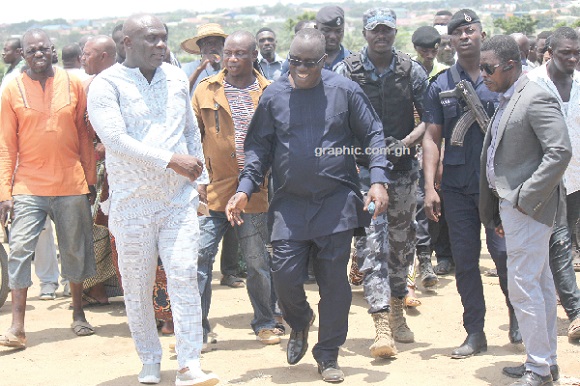
Forestry Commission to demolish illegal structures at Sakumono Ramsar site
The Forestry Commission has served notice that it will demolish all structures in areas it had marked as ‘no-go’ at the Sakumono Ramsar site.
Advertisement
The Chief Executive of the commission, Mr Kwadwo Owusu-Afriyie, made this known when he led a team comprising chiefs, officials of the Tema Development Company, the Tema West Municipal Assembly and security services, to inspect the Sakumono Ramsar site at Sakumono, near Tema yesterday.
“This is to give warning that if you have any structure here, don’t come again and continue because they are all going to go down. Even if you build it in the night, we will not let it stand, it will go down.
“We are going to ensure that not only do we talk about it; we also walk the talk. We are going to demolish all these structures. We have the support of the chiefs. It is not right that we should witness this massive encroachment. I am not happy with what I have seen. We are not going to go back and sleep,” he said.
Invasion
The Sakumono Ramsar site has been invaded by real estate developers and encroachers. As a result, hundreds of acres of the once vibrant wetland have disappeared and been replaced by endless rows of completed and uncompleted structures.
According to the Forestry Commission’s estimates, about 620 acres, including portions of the site cultivated under the Coastal Wetlands Management Project from 1995 to 2000, had been razed down.
Some portions of the site have also been allegedly sold out to unsuspecting members of the public.
But addressing some chiefs and residents of the area, Mr Owusu-Afriyie said “all those who alleged that they bought land from chiefs should go back and collect their money. If they got it for free, fine, they have nothing to worry their heads about. Whatever it is, we will not let these buildings stand”.
He, however, said the Forestry Commission would allow some of those who had completed properties outside its demarcated areas to atone their tenancy.
He said while the commission would not build any walls on the site as boundaries, it would rely on its Rapid Response Team to ward off encroachers.
Eco-tourists site
To help save the site, the Commercial Development Manager of the Forestry Commission, Rev. David Kpelle, said the commission had developed a concept note for the development of the site into a modern wetland-based eco-tourist site.
To be named the Sakumono Ramsar Site Eco-centre, it would provide urban recreation, nature appreciation and eco-tourism within the Accra and the Tema metropolises for both local and international tourists and also serve as a diversified source of revenue for the commission.
Although located very close to the Sakumono Lagoon, which sometimes overflows its banks during the rainy season, it appears people are not deterred from acquiring such lands for development.
“We want to turn this place into a medical tourism site where people are paying a lot of money elsewhere to go and visit. We can create opportunities here where we all benefit,” he said.
The Chief of Klagon, Nii Bortey Klan, pledged to assist the Forestry Commission to ward off new developers in the area, as he had bought into the idea that the Forestry Commission’s plans would create more opportunities for the area.
Sakumono Ramsar site
The Sakumono Ramsar site is the only wetland wholly owned by the government and is meant for protecting Sakumono, Tema and their environs against floods and pollution, for the breeding of fish for the Sakumono Lagoon, as well as recreational activities.
The Ramsar site is also the relaxation and feeding grounds for over 70
Besides, it serves as breeding grounds for about three marine turtle species.
The Forestry Commission maintains that the
It has a catchment area of 222km2 from which water drains into the 1.6km2 Sakumono Lagoon.



